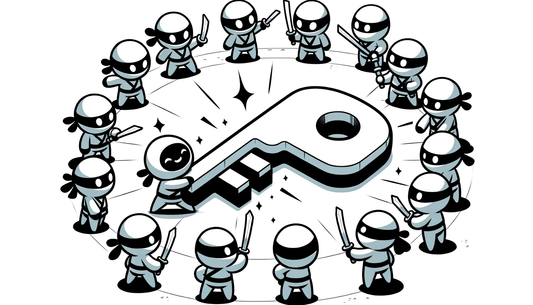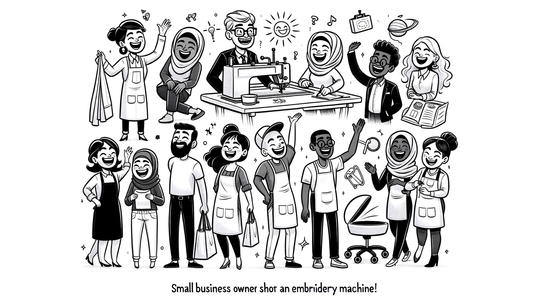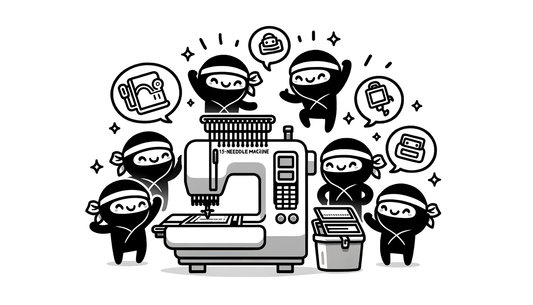
Decoding Embroidery File Formats: A Beginner's Guide
Share
Embroidery is a fantastic way to personalize and add flair to garments, home decor, and more. But before you can bring your creative visions to life, it's crucial to understand the language your embroidery machine speaks: file formats. Using the wrong file format can lead to frustrating errors, wasted materials, and designs that simply won't load. This guide will break down the most common embroidery file formats, helping you choose the right one for your machine and project.
Understanding the Basics: Common Embroidery File Formats
Different embroidery machines use different file formats to interpret design data. Here's a rundown of the most popular ones:
- DST (Tajima Stitch Format): The workhorse of commercial embroidery. Used by Tajima, Ricoma, Barudan, ZSK, and some Brother commercial models. DST files contain essential stitch data and basic color information, making them widely compatible.
- PES (Brother Embroidery Format): Primarily for Brother and Baby Lock machines, especially home-use models. PES files retain color sequences and machine-specific commands, optimizing performance on these machines.
- EXP (Melco Expanded Embroidery Format): Designed for Melco and Bernina machines. EXP files include stitch types, design placement, and limited color information. It's often used for transferring designs between brands.
- JEF (Janome Embroidery Format): The go-to format for Janome embroidery machines. JEF files store stitch data, color information, and design placement, ensuring compatibility.
- VP3, HUS, VIP (Husqvarna Viking, Pfaff): Used by Husqvarna Viking and Pfaff machines. These formats are designed to preserve extensive design details, including stitch data, color palettes, and design settings.
- XXX (Singer Embroidery Format): Specifically for Singer embroidery machines, XXX files contain both stitch and color information.
- EMB (Wilcom Editable Format): This isn't a machine format but rather a design/source file for Wilcom software. EMB files contain editable properties for design creation and modification within the software.
Machine Compatibility: The Key to Success
Each embroidery machine brand typically requires its own unique file format. Here's a general guide:
- Tajima: DST
- Brother/Baby Lock: PES (home machines), DST (commercial machines)
- Janome: JEF
- Melco/Bernina: EXP
- Husqvarna Viking/Pfaff: VP3, HUS, VIP, PCS, PCD, PCM
- Singer: XXX
Using the wrong file format can lead to a variety of problems, including the design not showing up on the screen, stitch-outs with errors, and wasted materials. It's like trying to play a Blu-ray disc on a DVD player – it simply won't work correctly.
If you're just getting started with embroidery and want a reliable machine that supports a wide range of formats (including the universally compatible DST), consider exploring the NinjaStarter from Embro Ninjas. Its compatibility and user-friendly interface make it an excellent choice for beginners.
The Solution: File Conversion Methods
What happens when your design file format doesn't match your machine's requirements? That's where file conversion comes in! Embroidery software like Embrilliance Essentials allows you to easily convert files from one format to another. Here's the general process:
- Open the embroidery design file in your software.
- Make any necessary adjustments to the design.
- Select "Save As" or click the save icon.
- Choose your desired save location.
- Rename the file (optional).
- Select the desired output format from the dropdown menu (e.g., DST, PES, JEF).
- Click "Save" to export the converted file.
Best Practices for Seamless Embroidery
To ensure a smooth and successful embroidery experience, follow these best practices:
- Consult Your Machine Manual: Always double-check your machine's manual to confirm the exact file format it requires.
- Specify Format When Ordering: When purchasing or commissioning designs, tell the digitizer your machine make and model so they can provide the correct file format.
- Retain Editable Files: Keep the original, editable design file (e.g., EMB for Wilcom) for future edits or reconversions. This gives you maximum flexibility.
- Backup is Key: Maintain organized backups of all your embroidery design files. You don't want to lose your precious designs!
- Test, Test, Test: Before embroidering on your final project, always test the converted file on scrap fabric. This helps you identify any potential issues and avoid costly mistakes.
- Understand Format Types: Use expanded formats like DST and EXP for broad compatibility, simple designs, or commercial use. Opt for machine-specific formats like PES, JEF, and VP3 for projects requiring precise color sequencing and advanced features.
- When in Doubt, Ask: If you're unsure about which format to use, contact your software provider or embroidery file supplier for clarification.
Having the right machine can make your selection a bit easier. With the Embro Ninjas NinjaStarter, you can unlock so many more possibilities! It's a 15-needle machine that can open up opportunities for all different embroidery styles. If you're looking for an upgrade, this is the machine for you.
Quick Machine/File Format Reference
| File Format | Machine Brand(s) |
|---|---|
| DST | Tajima, Ricoma, Brother (commercial), Barudan, ZSK |
| PES | Brother (home), Baby Lock |
| EXP | Melco, Bernina |
| JEF | Janome |
| VP3/HUS/VIP | Husqvarna Viking, Pfaff |
| XXX | Singer |
| EMB | Wilcom (software only) |
Troubleshooting Common Issues
Even with the right knowledge, issues can sometimes arise. Here's how to troubleshoot:
- Design Doesn't Appear or Stitches Incorrectly: Verify you're using the correct file format and convert the file again using embroidery software.
- USB Issues: Ensure your USB drive or card is formatted correctly and compatible with your machine.
- File Organization: Organize your files into folders as recommended by your machine's manual.
Before you make any big decisions, check out what to expect in a virtual demo! It will allow you to explore the best options without committing fully. To take the first step, schedule a call today and see what your options are!
Understanding embroidery file formats is essential for a successful and enjoyable embroidery experience. By following these guidelines and best practices, you'll be well on your way to creating beautiful and personalized projects.
The world of embroidery is vast, and each machine and creator is unique. We're here to help you find your best fit through machine personalization!
Question: Why are there so many different embroidery file formats?
Different machine manufacturers developed their own formats to optimize performance and retain specific design details for their machines.
Embroidery machines, much like computer printers, require specific instructions to function correctly. These instructions are encoded in different file formats. Over time, each manufacturer has tweaked their formats to best suit their technology and offer unique features. Additionally, some formats are designed to be editable within specific software, while others are meant solely for machine reading. The variety allows for optimization but necessitates conversion when designs are used across different machine brands.
Question: Can I use a DST file on any embroidery machine?
DST files are generally considered a universal format and can be used on many commercial embroidery machines, but compatibility isn't guaranteed for all home-use machines.
DST, or Tajima Stitch Format, contains the core stitch data necessary to recreate an embroidery design. Its simplicity and widespread adoption make it a common choice. However, DST files lack advanced color information and machine-specific commands found in other formats like PES or JEF. While many machines can read DST files, the design may not render perfectly, especially in terms of color sequencing. Always test the design on a piece of scrap fabric first to ensure proper stitch-out.
Question: Is it better to use a machine-specific file format or a universal one like DST?
Using a machine-specific file format is generally better for optimal performance and accurate color representation, but DST offers broader compatibility.
Machine-specific formats like PES, JEF, or VP3 are tailored to the intricacies of particular embroidery machines. They retain color palettes, stitch densities, and other advanced features that might be lost when converting to a universal format like DST. If you're working with a complex design or want to ensure the most accurate replication, a machine-specific format is the preferred option. However, if you need to share a design with someone who has a different brand of machine, DST is a good compromise. Remember to always consult your machine's manual for the recommended file format.
If you'd like to know more about embroidery, you can explore more by visiting our blog today! Click here!
Summary: Understanding embroidery file formats ensures designs load correctly on your machine, preventing errors and saving time. While universal formats like DST offer broad compatibility, machine-specific formats deliver optimal performance. Proper file conversion and testing are key to a seamless embroidery experience.


